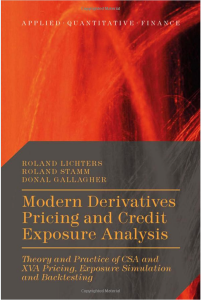
Roland Lichters, Roland Stamm, Donal Gallagher
Modern Derivatives Pricing and Credit Exposure Analysis: Theory and Practice of CSA and XVA Pricing, Exposure Simulation and Backtesting
The past 10 years have see an incredible change in pricing financial products, driven by the credit crisis which started in 2007 with the near bankruptcy of Bear Sterns, reaching a first climax with the implosion of the US housing market and the banking world’s downfall, and then turning into a sovereign debt crisis in Europe. A major change to have affected the landscape has been the increasing complexity in the valuation of derivatives – multi-curve pricing , various value adjustments (XVAs) using Monte Carlo simulation of markets through time , credit risk measurement and capital allocation – all based on increasingly complex mathematical and IT machinery.
Published in November 2015, Modern Derivatives Pricing and Credit Exposure Analysis is a comprehensive, practical guidebook for modern derivatives pricing and credit analysis, written with the practitioner in mind. Theoretically rigorous but focused on market practice, it provides a detailed and consistent toolkit of pricing and risk methods to cope with the increasing complexities of today’s derivatives management. The presented risk factor evolution models for six different asset classes allow efficient computation of various value adjustments (XVAs) and risk measures in a competitive and increasingly regulated environment. The text bridges the gap between the risk-neuraland real-world measure for backtesting purposes and explains different methods for speeding up XVA computation in order to allow fast calculations of margin adjustment or XVA greeks.
Written to provide sound theoretical detail with practical implementation, this book provides readers with both an overview and deep dive into valuation and risk methods applied in the industry today.
See the book at the Palgrave Macmillan website.
Part I – Discounting
- Discounting Before the Crisis
- What Changed With the Crisis
- Clearing House Pricing
- Global Discounting
- CSA Discounting
- Fair Value Hedge Accounting
Part II – Credit and Debit Value Adjustment
- Fundamentals: Unilateral and Bilateral CVA
- Single Trade CVA: Interest Rate Swaps, FX Forwards, Cross Currency Swap Flavours
Part III – Risk factor Evolution
- Monte Carlo Framework
- Interest Rates: Linear Gauss Markov Model, Stochastic Basis, CSA Discounting Revisited
- Foreign Exchange: Multi-Currency LGM, Cross Currency Basis
- Inflation: Jarrow-Yildirim and Dodgson-Kainth Models
- Equity and Commodity: One and Two-Factor Models
- Credit: Gaussian, Extended Cox-Ingersoll-Ross, Black-Karasinski and Peng-Kou Models
Part IV – XVA
- Cross Asset Scenario Generation
- Netting and Collateral
- Early Exercise and American Monte Carlo
- CVA Risk and Algorithmic Differentiation
- Funding Value Adjustment: FVA Debate, Expectation and Semi-Replication Approach, MVA
- Capital and Tax Value Adjustment: KVA by Semi-Replication, TVA
Part V – Credit Risk
- Fundamentals, Portfolio Credit Models
- Pricing Portfolio Credit Products: Synthetic CDOs, Cashflow Structures
- Credit Risk for Derivatives: Real-World Measure, SA-CCR, Internal Model Approach, CVA Capital Charge
- Backtesting: Framework, Risk-Factor Backtesting, Portfolio Backtesting
Part VI – Appendix
- The Change of Measure Toolkit
- The Feynman-Kac Connection
- The Black76 Formula
- Hull-White Model
- Linear Gauss Markov Model
- Dodgson Kainth Model
- Cox-Ingersoll Ross Model with Jumps
- Filtration Switching and the Peng-Kou Model
